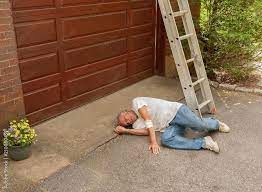Home Improvement can be dangerous for home owners using ladder

Introduction to Home Improvement Tasks and Ladder Safety
Many homeowners love to take on home improvement tasks themselves. It's a great way to save money and feel a sense of accomplishment. But before you climb up that ladder to clean your gutters or paint the trim, there's something important you need to know. Ladders can be deceivingly dangerous. Every year, thousands of people get injured because they didn't use ladders properly. We're not trying to scare you away from DIY projects. We're just here to arm you with knowledge so you can tackle your tasks safely. It all starts with understanding ladder safety basics. Whether you're a seasoned pro or a weekend warrior, it's crucial to always respect the height and stability of ladders. Choose the right ladder for the job, check it for any damage before use, set it up on solid ground, and never, ever overreach. Remember, staying safe means staying smart. So let's make sure those home improvements don't end up costing you more in the long run.
Common Home Improvement Tasks Requiring Ladders
Many home improvement projects demand a ladder, but not everyone knows which tasks are risky. Let's break it down. First, gutter cleaning stands out. Twice a year, clearing leaves and debris off your roof lines can lead you high up off the ground. It's easy to lose balance if you're not careful. Next, painting. Whether it's touching up the trim or covering an entire exterior wall, a ladder puts you at risk of falling if it's not properly secured. Then, there's window washing. For those living in multi-story houses, cleaning upper-floor windows without the right ladder stability is a gamble. Also, don't forget light fixture and ceiling fan maintenance. Reaching up to change bulbs or clean fixtures often means climbing. Lastly, roof repairs. Patching up a leak or replacing shingles requires height and precision, making it not only dangerous but also easy to underestimate. These tasks might seem straightforward, but each involves a risk when a ladder is involved. Always ensure safety measures are in place.
The Risks: What Makes Ladders Dangerous
Ladders seem simple, right? You open them, climb up, do your thing, and climb down. But here's the deal: every year, a shocking number of people land in the hospital because of ladder-related accidents. So, what's the big deal with ladders? First off, they're unstable. Unless you're on solid, even ground, there's a good chance your ladder can wobble or even tip over. Then there's the height factor. The higher you go, the riskier it gets. Falling from even a couple of feet up can cause serious injuries. Also, overreaching is a common mistake. You stretch too far to the side, and bam, the ladder's tipping over. And don't forget, carrying tools up there isn't exactly a walk in the park. You've got to balance yourself, hold onto your tools, and focus on not falling all at the same time. In short, ladders demand respect. They're not as easy as they look, and overlooking the risks can land you in a world of hurt.
Statistics on Ladder-Related Injuries Among Homeowners
Every year, thousands of homeowners grab their ladders to tackle home improvement tasks, unaware of the risks lurking. Here’s the hard truth: ladder-related mishaps lead to over 160,000 emergency room visits annually in the United States alone. Think about it, that’s a huge number. Most of these accidents happen not because the task is particularly dangerous, but because folks underestimate the ladder's role in their safety. They think it’s just about climbing up and down, but there's more to it. Slip-ups, overreaching, and using a ladder not suited for the task or in poor condition are common culprits behind these incidents. Surprisingly, it's not just the high climbs that result in visits to the ER. A significant portion of these injuries occur from falls from relatively low heights. This goes to show, whether you're changing a light bulb or cleaning out the gutters, taking ladder safety seriously is a must. Remember, it only takes a small mistake to turn a simple home improvement project into a trip to the hospital. Stay safe, folks.
Preventing Accidents: Choosing the Right Ladder
Choosing the right ladder is essential for home improvement tasks. It's not just about reaching high places but doing so safely. First off, understand the job. Is it indoor or outdoor? Does it require you to carry heavy stuff up with you? Answers to these will guide you. Now, ladders come in various types. Step ladders are good for indoors where you need stability. For outdoor tasks, especially where there’s no wall support, an extension ladder is your go-to. Make sure it's long enough to reach your work area comfortably without standing on the top rungs. Material matters too. Aluminum ladders are lightweight and perfect for most jobs, but they conduct electricity. So, if you're working near power lines, a fiberglass ladder is safer. It might be heavier and cost more, but your safety is worth it. Lastly, look at the duty rating. This tells you the maximum weight the ladder can handle. Always choose one that supports your weight plus any tools or materials you'll carry. Picking the right ladder can be the difference between a job well done and a trip to the emergency room. Keep it simple, but never skimp on safety.
Essential Ladder Safety Tips for Homeowners
When using ladders for home improvement tasks, safety should be your top priority. Each year, thousands get injured due to ladder accidents - but these are avoidable with the right knowledge and approach. Here's what you need to know: First, always make sure the ladder is on stable and even ground before climbing. A shaky foundation invites trouble. Second, inspect the ladder before use. Look for cracks, loose parts, or anything that seems off. If it looks questionable, don't use it. Third, maintain three points of contact on the ladder at all times - two hands and one foot, or two feet and one hand. This balance reduces the risk of falls. Also, don't overreach. If you can't easily grab something, safely climb down and reposition the ladder instead of stretching. Lastly, never climb a ladder during bad weather, especially if it's windy or wet. The risk isn't worth it. Follow these tips to keep your home improvement projects safe and efficient.
Alternative Tools and Techniques to Avoid Ladder Use
When tackling home improvement projects, reaching for a ladder might seem like the go-to solution. However, ladders can pose significant risks, especially for those not used to working at heights. Let's talk about safer alternatives that get the job done without the climb. First up, extension poles. They're your best friends for painting, dusting high corners, or even changing light bulbs from the safety of the ground. Next, consider investing in a scaffolding system for bigger projects. They offer stable platforms and are ideal for jobs requiring more time up in the air. For gutter cleaning or low-level roof repairs, telescopic or extendable tools specifically designed for these tasks can eliminate the need for ladders altogether. And don't forget about the power of technology – drones can be used for inspecting roofs or gutters, giving you a bird's eye view without ever leaving the ground. Each of these alternatives not only keeps you safer but can also make the work quicker and less of a hassle. Remember, the goal is to complete your home improvement projects effectively but safely.
How to Properly Set Up and Use a Ladder
To avoid getting hurt while using a ladder, you gotta set it up right and use it correctly. First, always choose the right ladder for the job. It has to be strong enough to hold you and whatever you're carrying. Never use a ladder that looks damaged or wobbly. Place the ladder on stable, level ground and make sure it's not leaning sideways. If it's an extension ladder, follow the 4-to-1 rule for safety. For every 4 feet of height you’re climbing, move the base 1 foot away from the wall. Before you climb, make sure the ladder's feet are well secured and the extensions are fully locked in. While climbing, keep your body centered between the sides of the ladder. Never lean too far to one side; you might lose your balance and fall. And remember, only one person on the ladder at a time to avoid tipping it over. Stick to these tips, and you’ll keep yourself out of harm’s way while tackling those high-up home improvement tasks.
When to Call a Professional Instead of DIY
Sometimes, confidence can cloud judgment, especially when it comes to tackling home improvement projects. Standing on a ladder might seem simple, but not every task at height is a DIY job. Here are straightforward signals that it's time to call in a professional: when the task requires specialized tools you don't own or know how to safely operate; if the project is near power lines, because one wrong move could be disastrous; or when the task requires working on a steep or high roof. Professionals have the right equipment and training to do the job safely and efficiently. Remember, saving a few bucks by avoiding a professional fee isn't worth the risk of a fall or serious injury. In the realm of home improvement, it's smarter to know when to step back and let the experts take over. You can call the professionals at Renueit. Go to their website at www.myreueit.com for more information.
Summary: Ensuring Safety During Home Improvement Projects
When tackling home improvement projects, especially those involving ladders, your safety must be top priority. Before you start, check your ladder for any damage. A shaky or broken ladder is a no-go. Place it on stable, even ground to prevent falls. Don't stretch beyond your reach; if you can't easily get to the spot, move the ladder closer. Always face the ladder when climbing or descending, and keep both feet on the rungs—not the sides. Use a tool belt or have someone pass tools and materials up to you. This keeps your hands free for climbing and balancing. Remember, taking these steps isn't about slowing you down—it's about making sure you can enjoy your home improvements without injury.

